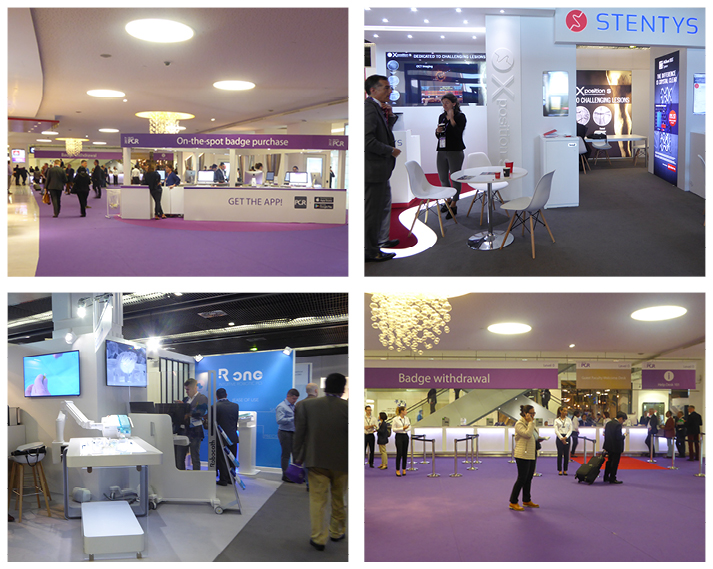This year’s EuroPCR congress was held in the metropolitan city of Paris, France. EuroPCR is the official annual meeting of the European Association of Percutaneous Cardiovascular Interventions (EAPCI). Known for its wide boulevards, fashion, and culture, Paris provided a magnificent backdrop for this year’s meeting. Over 12,000 attendees came together in France’s capital city to share the very latest research, developments, and best practice in treating cardiovascular conditions. Speaking at the opening ceremony, one of the EuroPCR course directors, Dr Jean Fajadet, Clinique Pasteur, Toulouse, France, announced: “EuroPCR has grown to become a platform for exchange and networking, helping us to help our patients. So, PCR brings together community initiatives within interventional medicine.” In our congress review section, we provide a summary of the event, highlighting major news releases to ensure you do not miss out on anything.
The scientific programme this year was designed around four key aspects: Themes, Topics, Focus, and Formats. This enabled participants to find a theme they were interested in within a specific field focus and then choose an educational format that enabled them to maximise their learning experience. With the programme spanning >350 sessions, there was something for everyone. The programme also received significant input from the cardiology community, who submitted a wide variety of abstracts, clinical cases, images, innovative works, and late-breaking trials. Half the sessions at EuroPCR were based around these submissions. Feedback, garnered from social media and questionnaires, was utilised to design a unique, new series of sessions for younger interventional cardiologists. For example, the ‘evidence-practice mismatch’ sessions. These provided insight into cases where physicians may not adhere to guidelines in practice. Participants were provided with the opportunity to discuss these cases and come up with solutions.
Innovation was a thread that ran throughout the meeting, with clinical investigators at the forefront of innovation presenting their most recent findings. The importance of innovation was touched upon at the opening ceremony, with Dr Jean Fajadet noting: “So, to reach a point of being able to offer patients friendly solutions to their problems requires a journey from research to implementation of innovation. That is a community that meets here as well.” Furthermore, Innovators Day was held the day prior to EuroPCR to allow key innovation players in the European cardiovascular community the chance to network.
Another major feature of the meeting was the 40th anniversary of angioplasty. To honour this event, there was an exposition featuring the major milestones throughout the history of interventional cardiology. This exposition provided fascinating insight into the field and its development, and it highlighted some of the major players and driving forces behind shaping it. One intriguing display showcased early catheters and stents, which enabled viewers to visualise just how far the technology had developed. Another highlight was a short film on the first human percutaneous coronary angioplasty, carried out in 1977 by Andreas Grüntzig. Additionally, there was a feature providing details of the individuals behind some of the pioneering innovations in interventional cardiology, such as Dr Ibrahim Al-Rasdan (Kuwait), Dr Jorge Berlardi (Argentina), and Prof Ulrich Sigwart (Switzerland). There was a strong sense of community-created history in the exposition; attendees were encouraged to share their own stories and knowledge. For instance, there was a ‘First Timers Map’, which congress attendees could add to and provide details of the first people to carry out procedures in a country.
We hope you will take something of value away from perusing our highlights, and very much look forward to seeing many of you at next year’s meeting, which will once again be hosted in Paris.

Effect of Bivalirudin Versus Unfractionated Heparin on Infarct Size Reduction for PPCI in Large AMI
BIVALIRUDIN versus unfractionated heparin (UFH) was investigated to determine whether infarct size (IS) was reduced for primary percutaneous coronary intervention (PPCI) in large acute myocardial infarction (AMI). The results of this prospective, randomised, multicentre, open-label study were reported at the EuroPCR congress held in Paris, France.
The study enrolled 78 patients, randomised (1:1) to either bivalirudin or UFH. Patients randomised to the bivalirudin subgroup received 0.75 mg/kg (bolus) and 1.75 mg/kg per hour (infusion) for the procedure duration, as well as administration for 4 hours post-PPCI completion to maintain thrombin inhibition. UFH patients were assigned dosage as per standard practice at each institution. A value of ≥250 seconds was proposed for cases where active clotting time was considered to determine UFH dose. Four study centres participated.
The primary endpoint, defined as IS, was measured using cardiac magnetic resonance (CMR) 5 days post-PPCI. No statistically significant reduction was noted for mean IS at 5 days, (bivalirudin 25.0±19.7 g versus UFH 27.1±20.7 g [p=0.75]).
Secondary endpoints were index of microcirculatory resistance (IMR), CMR-assessed microvascular obstruction and ejection fraction, and thrombin activity and cell injury biomarkers. Initial microvascular obstruction was lower for bivalirudin patients, 5.3±5.8 versus 7.7±6.3 g (p=0.17). There was no substantial difference in ejection fraction at 90 days. For biomarkers, thrombin- antithrombin complexes were reduced in the case of bivalirudin (-4.8 µg/L), versus UFH which increased (+1.9 µg/L [p=0.0003]). IMR, which was measured in 52 patients, was lower with bivalirudin when distal coronary artery pressures were similar (bivalirudin 43.5±21.6 versus 68.7±35.8 mmHg x s [p=0.014]).
In the acute phase, bivalirudin completely inhibited thrombin production ≤10 minutes from the completion of PPCI. UFH failed to prevent an increase in thrombin generation. Although IMR was decreased, IS was not; therefore, the primary study endpoint was not met and discontinuation of the trial resulted. Trial limitations, including the small sample size (N=78), should be acknowledged and the results should be approached with care. In conclusion, a substantial reduction in IS in PPCI by prolonged bivalirudin administration as opposed to UFH was not achieved.

Pilot Trial of Rapidly Induced Therapeutic Hypothermia Shows Promising Results
A PILOT trial of rapidly induced therapeutic hypothermia in patients with anterior ST-elevation myocardial infarction (STEMI) without cardiac arrest found results that suggested it would be appropriate to commission a pivotal trial to further investigate efficacy. The results of the COOL AMI EU pilot trial were reported at the EuroPCR congress held in Paris, France.
This pilot study had its genesis in unpublished post hoc subgroup analyses of the COOL MI and ICE-IT clinical trials and combined analysis of RAPID MI-ICE and CHILL MI14; these analyses implied that, if rapid cooling was used to decrease core temperature before the opening of the infarct-related artery, patients might benefit from therapeutic hypothermia. The aim of the study was to consider safety and feasibility issues of faster and more profound cooling than in other clinical studies and to assist in the determination of sample size calculations for a larger pivotal trial.
Fifty patients with anterior STEMI were randomised 1:1 to either the control group or the cooling group. These two study groups were comparable in terms of BMI, age, sex, and risk factors for coronary disease. Patients in the cooling arm were cooled to 33.6°C, which was at least 1.1°C lower than in recent cooling trials, over the course of 20.5 minutes. Per protocol analysis showed that, in the cooling group, median infarct size/left ventricular mass was 16.7%, in comparison to 23.8% in the control group. Furthermore, mean left ventricular ejection fraction was 42% and 40% in the cooling and control groups, respectively. While this was not statistically significant, the authors felt this warranted further evaluation for efficacy in a pivotal trial. The only notable difference in adverse events was a greater incidence of self-terminating paroxysmal atrial fibrillation in the cooling group (32% versus 8; p=0.074); however, during the warming phase, this spontaneously resolved to sinus rhythm and required no further treatment.
As this was a pilot trial, limitations should be considered. One such limitation is that the trial was not sufficiently powered to detect differences in left ventricular ejection fraction and infarct size/left ventricular mass. It is calculated that the pivotal trial should enrol a total of 468 patients.

Utility of Post-Intervention Fractional Flow Reserve Measurement
AN ASSOCIATION between post-percutaneous coronary intervention (PCI) fractional flow reserve (FFR) measurements and clinical outcomes, using a specific rapid exchange FFR microcatheter with exchangeable guidewire capability, may reveal a novel role for FFR in catheterisation laboratories. The results of this study were reported in a press release from EuroPCR, dated 18th May 2017. Early results indicate that microcatheter-based FFR may be feasible in numerous clinical settings.
Preliminary results from the independent, physician-sponsored FFR-registry were unveiled at EuroPCR by investigators based at the Erasmus Medical Centre (Erasmus MC), Rotterdam, Netherlands. To determine the association between post-PCI FFR and clinical outcomes, >1,000 consecutive patients, who had been diagnosed with either stable angina or acute coronary syndromes (ACS) and been treated with PCI, were enrolled into the registry. Clinical outcomes were measured at several intervals: 30 days, 1 year, 2 years, and 5 years.
Initial analysis of 30-day data concluded that FFR measurements >0.90 led to a major adverse cardiovascular event (MACE) rate of 1.5%. Measurements of <0.9% lead to a MACE rate of 2.3% (p=non-significant). MACE rates increased as the FFR measurements lowered. Patient sub-groups with FFR measurements <0.9 could not demonstrate statistical differences between cohorts. However, FFR measurements of 0.86–0.90, 0.81–0.85, and ≤0.80, resulted in MACE rates of 2.0%, 2.6%, and 2.8%, respectively.
Dr Nicholas Van Mieghem, co-principal investigator, Director of Interventional Cardiology, Thoraxcenter, Erasmus MC commented: “The preliminary data from FFR-Search has the potential to significantly expand this technology’s role in the cath lab in the future, which is why we are eager to see the important results of the primary endpoint at 2 years.”
To determine potential causes for low post-procedural FFR, in 60 patients with an FFR value ≤0.85, intravascular high definition ultrasound analysis was carried out. In 84% of cases, stent under-expansion was the most common cause. This was followed by focal lesions distal to the stent (52%), focal lesions proximal to the stent (43%), and malposition of the stent (22%).
Existing patients will continue to be monitored throughout the remaining duration of the trial, to determine a more conclusive understanding on the potential application of post-PCI FFR in clinical practice.
Efficacy of Percutaneous Coronary Intervention in Coronary Total Occlusion Patients
PERCUTANEOUS coronary intervention (PCI) achieves a high procedural success rate in patients with coronary total occlusion (CTO), according to results of the EURO-CTO trial presented in a EuroPCR press release dated 18th May 2017. The study found that bigger improvements in clinical symptoms were seen in CTO patients treated with this method compared to those who underwent the more commonly utilised optimal medical therapy, a finding that could lead to PCI becoming the primary treatment option for this group of patients.
Currently only 7% of PCI procedures are for patients with CTO, a condition that occurs in ~20% of stable coronary artery disease patients. In contrast to non-occlusive lesions, a CTO is not accepted as an indication to perform PCI in current guidelines for managing coronary artery disease because of a lack of evidence on the benefits of PCI in CTO patients.
To gain a better insight into the efficacy and safety of PCI for CTO, the EURO-CTO trial enrolled 396 patients from 26 centres, who were then randomised to receive PCI or optimal medical therapy at a ratio of 2:1, respectively. Of the participants, 50% had single-vessel CTO and 30% had a non-CTO lesion treated before randomisation. Optimal medical therapy included anti-anginal drugs as well as standard secondary prevention methods. At follow-up, 9 patients moved from optimal medical therapy to PCI.
The results showed that in 86.3% of patients treated with PCI, the CTO was successfully opened. Additionally, there was a low procedural risk with this treatment method; no procedural deaths occurred and the 12-month major adverse cardiac and cerebrovascular events (MACCE) rate was 0.4%. PCI results were more favourable than optimal medical therapy, with more pronounced clinical symptoms, improved quality of life, and significantly greater absolute freedom from angina seen in PCI-treated patients.
“The clinical symptoms and wellbeing of patients with CTO improve more efficiently with PCI than with optimal medical therapy. PCI should be the primary treatment option for these patients,” stated lead author Prof Gerald Walter, Director of the Cardiology Department, Klinikum Darmstadt, Darmstadt, Germany.

Deferred Revascularisation: Study Indicates Low Risk Based on Intracoronary Physiology Measures.
THE LARGEST real-world study on revascularisation in patients with stable angina and acute coronary syndrome (ACS) determined that deferring revascularisation on the basis of intracoronary physiology, using either fractional flow reserve (FFR) or instantaneous wave-free ratio (iFR), was accompanied by low risk of substantial adverse coronary events. The results of this study were reported in a press release from EuroPCR, dated 16th May 2017.
Functional intracoronary measurements with pressure guidewires are largely carried out in coronary stenosis patients with a defined condition severity of ‘intermediate’ to determine the extent a stenosis has on blood flow restriction. For this particular subset of patients, there is restricted evidence on the safety of deferring vascularisation. Recent studies, DEFINE FLAIR and iFR SWEDEHEART, did not specifically report on patients whose procedures were deferred. However, data from the two trials did show positive outcomes for intermediate stenosis patients undertaking physiology-guided revascularisation.
The analysis in this study was derived from pooled data, originating from the two previously mentioned studies, and included information from 4,529 enrolled patients. The study’s purpose was to determine the impact of deferring procedures. It was concluded that significantly fewer patients experienced interventions when iFR was used for measurement in comparison to FFR, (50% versus 45%; p=0.01).
In 2,130 patients with deferred myocardial revascularisation, the rate of major adverse cardiovascular events (MACE) was low (iFR; 4.12% and FFR; 4.05% at 1 year). The rate of MACE was lower in patients with stable coronary disease (SCD) compared to ACS (3.6% versus 5.9%; p=0.04).
“The findings support the safety of deferring revascularisation based on iFR or FFR,” explained lead study author Dr Javier Escaned, Consultant Interventional Cardiologist, Hospital Clínico San Carlos, Madrid, Spain.
Significant differences in event rate were observed for ACS and SCD when FFR was used as the method of assessment (ACS: 6.4% versus SCD: 3.4%; p=0.049). The variance was less defined for iFR (ACS: 5.4% versus SCD: 3.8%; p=0.37). Further data would be beneficial to better understand and further support the role of physiological evaluation in patients with ACS.
Switching Therapies Can Reduce Risk of Minor Bleeding Events
SWITCHING treatments after acute coronary syndrome (ACS) treated with percutaneous coronary intervention (PCI) could improve outcomes, according to the results of a study reported in a EuroPCR press release, dated 16th May. This randomised study, led by Dr Thomas Cuisset, CHU Timone, Marseille, France, was the first to compare the two dual antiplatelet therapies (DAPT).
Prasugrel and ticagrelor are novel P2Y12 inhibitors that have been combined with aspirin to become the first-line initial DAPT following ASC. This treatment has been extended to 1 year. A reduction in ischaemia has been found during the first 30 days as a result of this DAPT regimen, yet during long-term maintenance treatment a significant increase in bleeding risk was reported.
Investigators in the TOPIC study administered a newer P2Y12 inhibitor administered with aspirin for 30 days after a PCI for ASC. Following this, maintenance DAPT with clopidogrel plus aspirin was used. The aim was to investigate whether this would lead to reduced risk of bleeding without any ischaemic adverse effects.
The study enrolled 646 ACS individuals who were undergoing PCI. These individuals were treated for 1 month with a new P2Y12 inhibitor plus aspirin. They were then randomised to either continue with this therapy or change to aspirin (75 mg) plus clopidogrel (75 mg). The combined primary endpoint was death, bleeding (classification of ≥2 with Bleeding Academic Research Consortium [BARC]), stroke, and urgent revascularisation. After 1 year, this was reported to be 52% lower for individuals who switched to aspirin plus clopidogrel, in comparison to individuals who continued to receive a new P2Y12 inhibitor plus aspirin (13.4% with switched DAPT versus 26.3% with unchanged DAPT; hazard ratio [HR]: 0.48; 95% confidence interval [CI]: 0.34–0.68; p<0.01).
Ischaemic events between the two dual antiplatelet regimens were reported to have no difference, as 9.3% of individuals had an ischaemic event on switched DAPT versus 11.5% individuals on unchanged DAPT (HR: 0.80; 95% CI: 0.50–1.29; p=0.36). Moreover, individuals who switched DAPT demonstrated a 70% lower bleeding rate, compared to those unchanged (4.0% versus 14.9% at 1-year; HR: 0.30; 95% CI: 0.18–0.50; p<0.01).
Dr Cuisset expressed his optimism for the study: “This strategy could be proposed in ACS patients. We think that this trial could change practice.”
Excellent Clinical Outcomes Displayed for Two Transcatheter Aortic Valve Implantation Systems
EXCEPTIONAL safety and efficacy profiles for two self-expanding transcatheter aortic valve implantation (TAVI) systems were displayed in two clinical trials, the results of which were presented in a EuroPCR press release dated 16th May 2017.
Firstly, the ADVANCE clinical trial analysed the performance of the CoreValve™ System (Medtronic, Dublin, Ireland) in 465 real- world patients with severe aortic stenosis. At 5-year follow-up, the patients had sustained haemodynamic improvement (9.7 mmHg mean gradient at discharge; 8.8 mmHg mean gradient at 5 years), and 81% were classified as New York Heart Association (NYHA) Class I or II. Survival data in a higher-risk patient group were in line with other 5-year TAVI data in similar high-risk patient groups.
“As TAVI continues to be evaluated in lower-risk patients, the ability to demonstrate sustained valve durability over time is of increasing importance,” stated Prof Axel Linke, Heart Center, University of Leipzig, Leipzig, Germany, principal investigator of the ADVANCE study.
To examine the CoreValve Evolut™ R TAVI system (Medtronic), a cohort of 1,038 patients with a mean Society of Thoracic Surgeons Predicted Risk of Mortality estimate of 5.5% were enrolled in the Evolut R FORWARD clinical study. This was a global, single-arm, prospective study covering 53 centres over four continents. At 30 days post-implant, a high survival rate (98.1%) and low rate of disabling stroke (1.8%) were displayed. Haemodynamic performance was also very high, with a reduction in the mean aortic valve gradient from 41.7±16.1 mmHg at baseline to 8.5±5.6 mmHg at discharge.
“The FORWARD results with a large patient cohort are encouraging, as these data support the clinical safety and effectiveness of the Evolut R System,” commented Prof Eberhard Grube, Center of Innovative Interventions (CIIC), University Hospital Bonn, Bonn, Germany.
Overall, these clinical trials add to the evidence that the CoreValve and Evolut R systems achieve high survival rates, excellent haemodynamics, and low rates of stroke in patients with severe aortic stenosis, providing confidence to heart teams in their ability.

Transcatheter Aortic Valve Implantation Demonstrates Lower Stroke Risk Than Surgical Aortic Valve Implantation
THE RISK of early neurological complications, such as stroke, has been found to be lower in individuals at intermediate risk for surgery when treated with transcatheter aortic valve implantation (TAVI) surgery compared with those treated with surgical aortic valve replacement. The findings from the large, randomised SURTAVI trial were shared on 18th May in a press release issued at EuroPCR 2017.
Individuals at intermediate risk for surgical mortality requiring aortic valve replacement are being treated with TAVI more frequently. However, long-term morbidity and an increased risk of death are also factors that individuals undergoing valve replacement are presented with.
The trial recruited 1,600 patients, all with intermediate surgical risk and severe, symptomatic aortic stenosis, and randomised them to aortic valve replacement with surgery or TAVI. Individuals who were suspected of displaying neurological events after their procedure were referred to a stroke specialist or neurologist for further evaluation.
At 30 days, it was reported that incidents of early stroke were lower in patients undergoing TAVI (3.3%), compared to individuals having surgical aortic valve replacement (5.4%; p=0.031). Patients treated with TAVI compared to surgery demonstrated lower stroke incidences at 2 years (6.3% versus 8.0%; p=0.143). Results also confirmed that 1-year mortality was similar for surgery individuals with stroke or encephalopathy at 30 days compared to TAVI patients.
Quality of life was also found to be lower at 30 days for patients with early stroke compared to individuals not having a stroke, based on the SF-36 physical summary. TAVI patients with stroke had a quicker improvement in quality of life; however, it was reported to be similar at 6 months regardless of procedure type.
Prof Pieter Kappetein, Erasmus MC, Rotterdam, Netherlands, expressed the importance of this study, explaining: “This is the first time that there has been shown to be a lower stroke rate with TAVI compared to surgery.”
Exciting Results of Bioresorbable Stent Technologies Show Need for Further Development
BIORESORBABLE stent (BRS) technologies were a major topic of discussion at the EuroPCR Congress 2017, with a statement issued by the EAPCI and results of late-breaking trials displayed throughout the event, as described in a EuroPCR press release dated 19th May 2017.
Following questions regarding the safety of a particular BRS, EuroPCR issued a statement to encourage further developments in these devices. They stated that the continued development of BRS technologies was crucial in order to improve this approach for future patients. They outlined the encouraging results of devices evaluated during the congress but urged that current-generation BRS should not be used ahead of metallic drug-eluting stents in routine clinical practice until concerns about their limitations are assuaged.
The results of several BRS trials were reported at EuroPCR. The RENASCENT II study was a prospective multicentre trial assessing 9-month clinical and imaging outcomes of the APTITUDE® BRS (Amaranth Medical, Mountain View, California, USA) stent, a novel ultra-high molecular weight poly-L-lactide BRS.
This reported excellent results: no events in 60 patients treated for single lesion coronary artery stenosis at 1-year follow-up, and excellent wall apposition and full homogenous endothelial wall coverage was demonstrated with optical coherence tomography.
In the DESolve Nx Study, which sought to evaluate imaging outcomes and 4-year clinical and imaging results from the DESolve® Novolimus-Eluting Coronary BRS (Elixir Medical Corporation, Milpitas, California, USA), a mean lumen gain of 9% was shown at 6 months and an angiographic late luminal loss of 0.2 mm. The study was a prospective registry including 126 patients.
“This is a clinical breakthrough as no other BRS technology has been successful in achieving such impressive results and, at the same time, degrading in 6 months with near complete resorption (mass loss) in 1 year,” stated lead author Dr Stefan Verheye, ZNA Middelheim, Antwerp, Belgium.
The positive results further underline the need for this approach to be developed in the future to complement other devices, to achieve optimal outcomes in patients.

Encouraging Trial Results for First Fully-Dissolving Heart Stent
RESULTS from two randomised clinical studies, ABSORB China and ABSORB Japan, were announced by Abbott, Chicago, Illinois, USA, on 16th May at EuroPCR 2017. These trials were comparing Absorb (Abbott), which is the first heart stent that completely dissolves, with XIENCE (Abbot). Dr Charles Simonton, Chief Medical Officer for Abbott’s vascular business shared his views on these studies: “Three-year results from the ABSORB China and ABSORB Japan trials provide reassuring data about the longer-term efficacy and safety of Absorb.”
Safety and efficacy results from the ABSORB China trial (N=475) continued to be favourable from 2 years to 3 years. Indeed, there were no new reports of stent thrombosis in either study arm since 2-year follow-up.
Furthermore, at 3 years, the cumulative rates of target lesion failure (TLF) were comparable between Absorb and XIENCE. There was no significant difference stated. Absorb TLF rates were 5.5% compared to 4.7% for XIENCE (p=0.68). With regard to stent thrombosis, there were also no statistically significant differences reported: 0.9% for Absorb versus 0.0% for XIENCE (p=0.50). Dr Simonton announced that: “Three-year results of the ABSORB China study supports that implanting Absorb in appropriately sized vessels positively affects patient outcomes.”
In the ABSORB Japan trial (N=400), the Absorb and XIENCE arms were comparable, and no statistical differences at 3 years for efficacy and safety were reported. It should be noted that current standards for the implantation of Absorb classify 14% of vessels treated in the trial to be too small. Safety events were similar across both arms between 2 and 3 years. TLF for Absorb and XIENCE were both 1.6% (p=1.00). At Day 810, one incidence of stent thrombosis occurred in the Absorb arm due to an under expanded scaffold.
Cumulative 3-year adverse events for Absorb were reported to be higher than XIENCE due to high adverse event rates during the initial first 2 years of the study; however, these were not statistically significant. The rate of probable/definite stent thrombosis for Absorb was 3.6% compared to 1.6% for XIENCE (p=0.35). Absorb TLF rates were 8.9%, whereas XIENCE TLF rates were 5.5% (p=0.23). The next set of results expected to be announced are from the ABSORB IV study.








